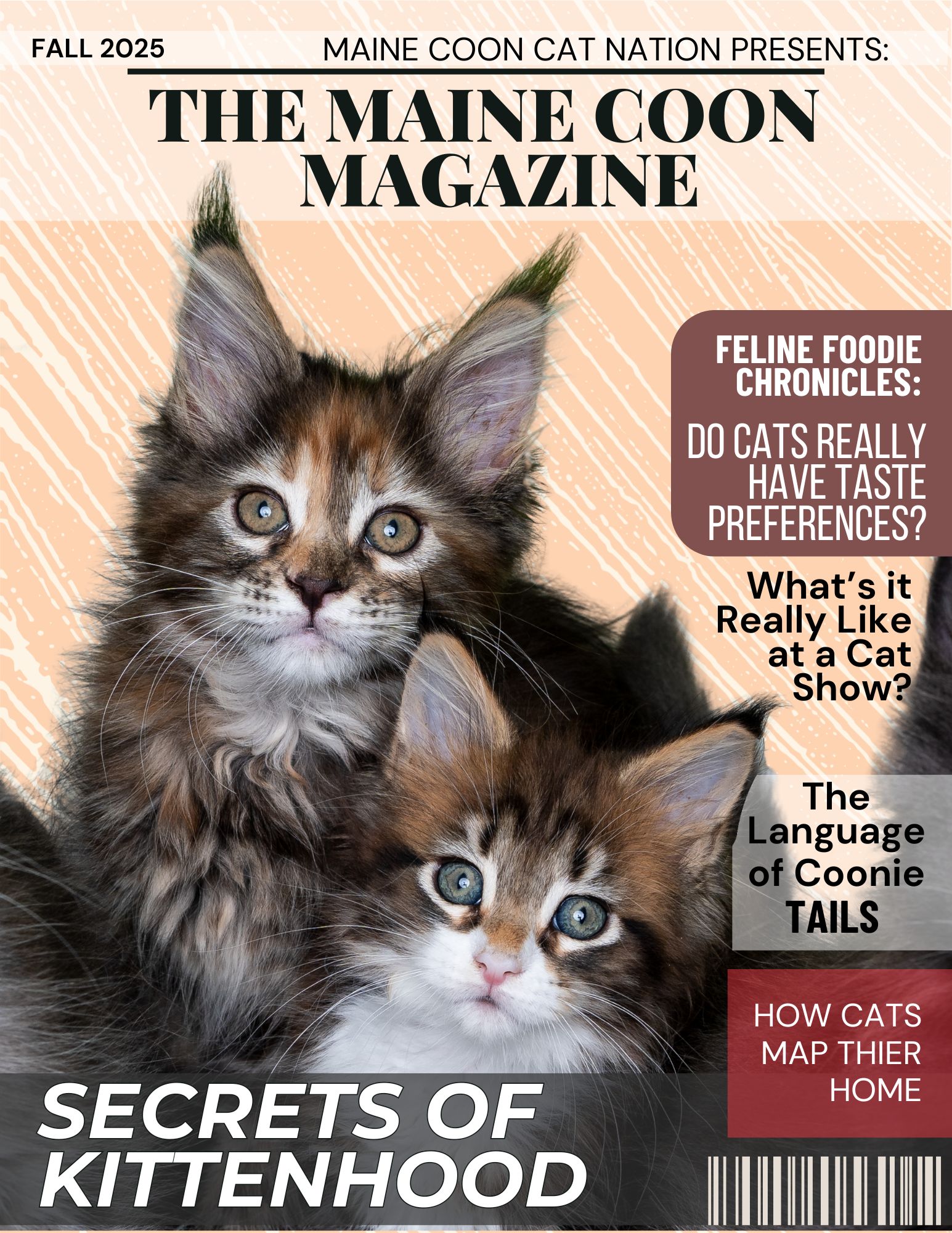- Home
- Maine Coon Care
- Letting Cats Outside
Letting Cats Outside: Should You Let Your Indoor Cat Out?
Many new cat owners ask whether letting cats outside is ok. The opinions of pet owners are strong and varied.
Let's look at indoors vs outdoors for Maine Coons.
It's a question all cat owners must ask themselves; "Should I let my cats outside?" Lets take a closer look.
Maine Coon Cat breeders will have new owners sign a care contract.
One of the items on this agreement is to keep your new Maine Coon as an indoor only cat, unless they are in a safe enclosure or supervised on a harness and leash.
Here, we'll talk about why your breeder may specify this. There are good reasons, and good solutions!
If you like this, you'll love our fun, free Daily Digest!

If you like this, you'll love our fun, free Daily Digest!

 Parker goes outside on a leash - a fun, safe way to enjoy the great outdoors!
Parker goes outside on a leash - a fun, safe way to enjoy the great outdoors!When deciding if you should let your cat outside, opinions can be very different. Some people think that cats need to explore the great outdoors to be happy.
This idea often comes from personal stories and memories of cats enjoying the fresh air, climbing trees, and lying in the sun.
Many believe that the freedom to explore is crucial for a cat's well-being, giving them lots of excitement and exercise.
On the other hand, more pet owners and experts now say that keeping cats indoors is safer.
They are concerned about outdoor dangers, like traffic, wild animals, diseases, and parasites.
Veterinarians and animal experts point out that indoor cats tend to live longer and healthier lives.
They argue that with the right toys and activities, cats can be just as happy indoors without ever stepping outside.
In this article, we’ll look at both sides of the argument, weighing the benefits of outdoor adventures against the risks.
For first-time cat owners, it’s important to understand these viewpoints to make the best choice for your feline friend.
Whether you prefer the idea of your cat enjoying the fresh air or believe in keeping them safe inside, the goal is to ensure a happy, healthy life for your Maine Coon.
Changing Perspectives
Personally, I have been on both sides of this topic. I grew up in a small city, and our cats always went outside when I was a kid.
They were careful about crossing the street, and mostly stayed in the yard. They all lived full lives as well.
But now, as the owner of two great Maine Coon cats, we keep them indoors. Our breeder specified it, and I agreed. You may wonder why I see things differently now.
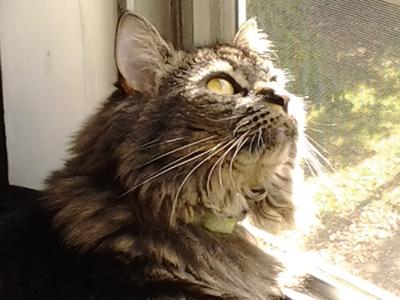 Church the Maine Coon cat, enjoying the view outside
Church the Maine Coon cat, enjoying the view outsideHistorical View on Letting Cats Outside
In the past, it was common to let cats roam freely outside. People believed that cats needed to explore the great outdoors to stay healthy and happy.
Cats were often seen hunting, climbing trees, and enjoying the fresh air. This was especially true in rural areas where the dangers of traffic and urban life were less of a concern.
For many years, the popular belief that cats belonged both indoors and outdoors was rarely questioned. It was simply the way things were done.
How Perspectives Have Shifted with Modern Pet Care Awareness
Over time, our understanding of pet care has evolved. Today, we know much more about the risks that outdoor life poses to cats.
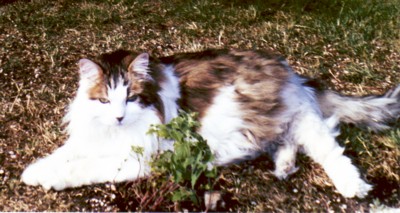
As we've learned about the dangers of traffic, wild animals, diseases, and parasites, more people have started to see the benefits of keeping cats indoors.
Advances in veterinary medicine and animal behavior studies have shown that cats can live long, happy lives without ever going outside.
We've also learned that indoor cats are less likely to suffer from injuries or illnesses, leading to a significant shift in how we care for our feline friends.
Influence of Breeders, Veterinarians, and Animal Welfare Organizations
Breeders, veterinarians, and animal welfare organizations have played a big role in this shift. Reputable breeders often require new cat owners to agree to keep their cats indoors.
They understand that this is the best way to ensure the health and safety of the cats they raise.
Veterinarians, with their firsthand experience treating sick or injured outdoor cats, frequently advise owners to keep their pets inside.

They see the benefits of indoor living every day and use their expertise to educate pet owners.
Animal welfare organizations also advocate for indoor living. They run campaigns and provide resources to help people create enriching indoor environments for their cats.
These organizations work to spread awareness about the risks of letting cats outside and the many ways to keep indoor cats happy and healthy.
Their efforts have led to more pet owners making informed decisions about their cats' lifestyles.
In conclusion, the historical view of letting cats outside has shifted dramatically. As our understanding of pet care has improved, so has our approach to keeping cats safe and healthy.
Breeders, veterinarians, and animal welfare organizations have all contributed to this change, helping us realize that indoor life can be just as fulfilling for our feline friends.
By considering these perspectives, we can make the best choices for our beloved Maine Coons, ensuring they live long, happy lives.
Benefits of Letting Cats Outside
Natural Behavior and Instinctual Fulfillment
For many pet parents, letting cats explore the outside world seems like a great way to let them follow their natural instincts.
Cats, whether they are domestic cats or feral cats, have an innate desire to hunt, climb, and roam.
These behaviors are part of their DNA. When allowed outside, cats can engage in activities like stalking birds, chasing insects, and climbing trees.
These activities fulfill their natural instincts and can make them feel more like their wild ancestors.
For first-time cat owners, seeing their feline friends exhibit these behaviors can be both fascinating and rewarding.
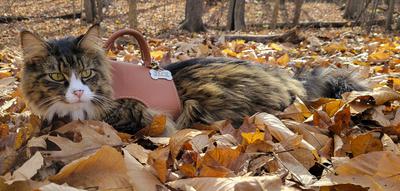 Jack
JackMany Maine Coon owners have found ways to successfully balance indoor safety with outdoor enrichment - like Jack in our 2022 Album and his outdoor adventures.
His owner, Robert, shares: "He loves to go for walks outside, loves his Catio, and enjoys drinking water from the kitchen sink."
Physical Exercise and Mental Stimulation
The outside world offers a lot of opportunities for physical exercise and mental stimulation.
Adult cats that go outside are more likely to stay active, which helps keep them fit and healthy.
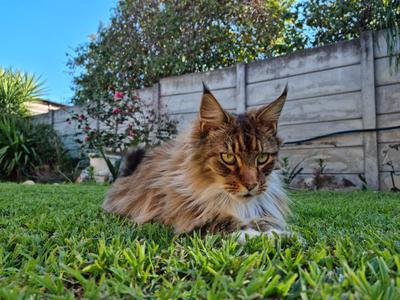
They get to run, jump, and climb, which are all excellent forms of exercise. This physical activity can help prevent obesity and related health problems.
Mentally, the outdoor environment is very stimulating. Cats are naturally curious creatures, and the sights, sounds, and smells of the outdoors provide endless entertainment.
They get to watch birds, listen to rustling leaves, and sniff interesting plants. This kind of mental engagement can prevent boredom and reduce stress, leading to happier cats.
For pet parents, a mentally and physically stimulated cat is often a well-behaved and contented pet.
Social Interaction with Other Animals
Another benefit of letting cats outside is the chance for social interaction with other animals. In the wild, cats are solitary hunters, but domestic cats often enjoy some level of social interaction.
When allowed outside, they can meet other cats and even other animals, like friendly dogs or curious squirrels.
This can be especially beneficial for cats that live alone without other pets at home.
Meeting other cats can help them learn social cues and behaviors. They may play, communicate, or simply observe each other from a distance.
This social interaction can be enriching, as it adds variety to their lives and can help them develop a broader range of social skills.
However, it's important for pet parents to remember that not all interactions will be positive, so monitoring these encounters is essential.
In summary, letting cats outside can provide significant benefits. It allows them to engage in natural behaviors, get plenty of exercise, and interact with other animals.
For both first-time cat owners and seasoned pet parents, understanding these benefits can help make informed decisions about their cat's lifestyle.
By considering the ways the outside world can enhance their cat's life, pet parents can create a fulfilling environment for their feline friends.
Risks of Letting Cats Outside
Health Risks
Exposure to diseases: Feline Distemper, Upper Respiratory Infections, FELV, FIV, FIP
When cats explore the outside world, they are exposed to many diseases that can harm them. Feline Distemper, for example, is a highly contagious and often deadly disease.
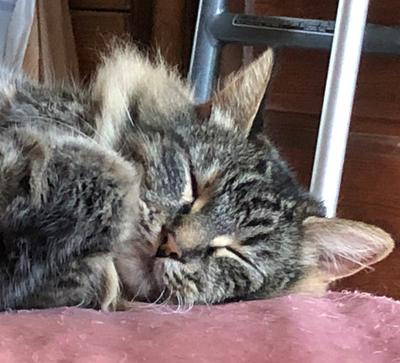
Upper Respiratory Infections (URI) can spread quickly among neighborhood cats and stray cats, causing sneezing, coughing, and other symptoms.
FELV (Feline Leukemia Virus) and FIV (Feline Immunodeficiency Virus) are both serious diseases that can weaken a cat's immune system, making it harder for them to fight off other illnesses.
FIP (Feline Infectious Peritonitis) is always fatal, causing severe health issues that lead to a painful end for affected cats.
Parasites: fleas, ticks, worms, Lyme disease, heartworms
Outdoor cats are at a high risk of getting parasites like fleas, ticks, and worms.
Fleas can cause itchy skin and spread other diseases, while ticks can transmit Lyme disease, which is dangerous for both cats and humans.
Intestinal worms, such as roundworms and tapeworms, can live in a cat’s intestines, stealing nutrients and making them sick.
Heartworms, spread by mosquitoes, are particularly dangerous as they can cause severe heart and lung problems.
Safety Risks
Traffic accidents
One of the biggest potential dangers for outdoor cats is traffic. Cats are quick and curious, but they don’t always understand the danger of busy streets.
Many cats get hit by cars each year, leading to serious injuries or death.
Attacks by dogs and wild animals

The outside world can be a dangerous place for cats because of other animals. Dogs and wild animals like coyotes can attack and seriously injure or kill cats.
These attacks are often sudden and brutal, leaving little chance for escape. Cat fights are a fact of outdoor cat life - these can result in injury, too.
Poisoning (accidental and intentional)
Cats that roam outside can accidentally get poisoned by things like antifreeze, pesticides, or poisonous plants.
Unfortunately, there are also cases where people intentionally poison cats, causing them immense suffering.
Human-related Risks
Getting lost or picked up by Animal Control or well-meaning cat lovers
Outdoor cats can easily get lost in a new environment. They might wander too far and not be able to find their way back home.
Sometimes, well-meaning cat lovers or Animal Control may pick up a cat, thinking it’s a stray, which can lead to the cat being taken far from home or put in a shelter.
Theft for sadistic purposes or laboratory use
Sadly, not everyone has good intentions. Some people steal cats for cruel reasons, including sadistic purposes or selling them to laboratories for experiments.
This is hard to fathom, and something that pet lovers don't want to think about.
Keeping cats indoors gives pet parents more peace of mind about their furry friend's safety.
Environmental and Social Risks
Impact on wildlife
Cats are natural hunters, and when they are outside, they can significantly impact local wildlife.
Birds, small mammals, and reptiles are often preyed upon by cats, which can upset the natural balance in an area.
Roaming into neighbors' yards and causing disturbances
Cats that roam freely can wander into neighbors' yards, leading to conflicts.

They might use gardens as litter boxes, hunt birds at feeders, or get into fights with other pets.
These disturbances can cause friction between pet parents and their neighbors. This is the most common cause for the above-mentioned poisoning danger.
Understanding these risks can help both first-time and experienced pet parents make informed decisions about whether to let their cats explore the outside world.
By weighing the benefits and risks, you can create a safe, happy environment for your furry friend.
Life Expectancy Comparison
Statistics on the Lifespan of Indoor vs. Outdoor Cats
The lifespan of pet cats can vary greatly depending on whether they live indoors or outdoors.
Indoor cats generally live much longer than their outdoor counterparts. On average, indoor cats live between 12 to 15 years, with many reaching 20 years or more.
In contrast, an outdoor kitty has a much shorter lifespan, typically living only 4 to 5 years.
Factors Contributing to the Longer Life Expectancy of Indoor Cats
Several factors contribute to the longer life expectancy of indoor cats.
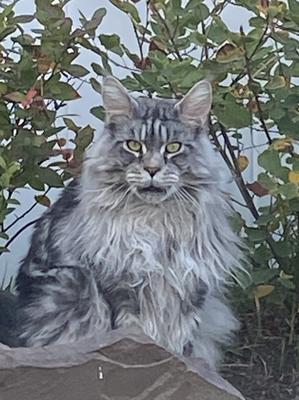
First, they are protected from many dangers that outdoor kitties face, such as traffic accidents, attacks by other animals, and exposure to harsh weather conditions.
Second, indoor cats have a lower risk of contracting diseases and parasites.
They are less likely to come into contact with other animals that might carry infectious diseases like Feline Leukemia Virus (FELV) or parasites like fleas and ticks.
Finally, indoor cats usually receive regular veterinary care. Pet cats living indoors are more likely to visit the vet for check-ups and vaccinations, which helps keep them healthy.
They also have a stable and controlled diet, reducing the risk of malnutrition or food-born illnesses.
By keeping your cat indoors, you can help them live a longer, healthier life.
Indoor environments can be enriched with toys, climbing structures, and interactive play to ensure your cat stays happy and engaged without the risks of the outside world.
Indoor Enrichment and Alternatives to Outdoor Access
There are plenty of easy ways to keep your indoor kitty happy and fulfilled!
Creating a Stimulating Indoor Environment
To ensure a happy life for your cat, creating a stimulating indoor environment is key.
This helps keep them mentally and physically active, reducing boredom and stress.
By providing plenty of activities and cozy spots, you can make their indoor space as exciting as the outside world.
Interactive Toys, Climbing Structures, and Window Perches
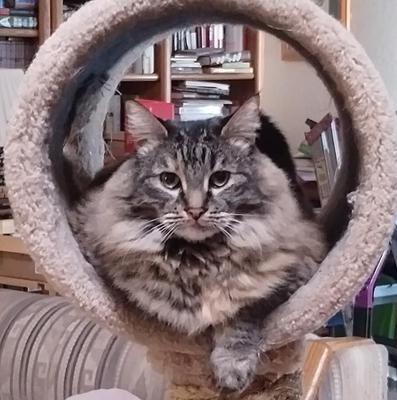
Interactive toys are great for keeping your cat entertained. Toys that move or make noise can mimic the thrill of hunting.
Climbing structures, like a cat tree, offer vertical space for exercise and exploration.
Window perches give your cat a front-row seat to the outside world, allowing them to watch birds and other activities from the safety of indoors.
The Concept and Benefits of Outdoor Cat Enclosures
Outdoor cat enclosures are a safe way to give your cat outdoor time.
These structures, sometimes known as "catios," provide a secure space where your cat can enjoy the fresh air and sights of the outside world without the risks.
They can be attached to a window or a screened-in porch, offering your cat a safe way to experience outdoor access.
Leash Training for Controlled Outdoor Experiences
Leash training is another option for giving your cat a taste of the outdoors.
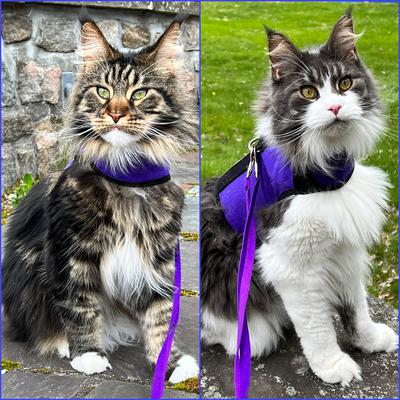 Violet and Khaleesi
Violet and KhaleesiWith patience and practice, your furry friend can learn to wear a cat harness and walk on a leash, allowing them to explore the new home surroundings safely.
This controlled outdoor time lets them enjoy the outside world while staying close to you.
By combining these indoor enrichment ideas and safe outdoor alternatives, you can provide a fulfilling and happy life for your cat without unsupervised outdoor access.

In warmer climates like South Africa, some Maine Coons - like Molly - enjoy supervised outdoor time, but only with precautions.
Her mom uses a pet locator, limits outings to cooler hours, and stays alert for unexpected wildlife.
Frequently Asked Questions (FAQ's) About Letting Cats Outside:
Is it safe to let my cat outside?
Is it safe to let my cat outside?
Letting cats outside can expose them to various risks such as traffic, predators, diseases, and parasites.
Weighing these risks against the benefits is important for pet owners.
Do indoor cats get enough exercise?
Do indoor cats get enough exercise?
Yes, with proper indoor enrichment like interactive toys, climbing structures, and regular playtime, indoor cats can get plenty of exercise.
How can I make my indoor cat happy?
How can I make my indoor cat happy?
Providing a stimulating environment with toys, cat trees, window perches, scratching posts, and interactive play can keep indoor cats mentally and physically satisfied.
What are outdoor cat enclosures, and are they safe?
What are outdoor cat enclosures, and are they safe?
Outdoor cat enclosures, or "catios," are secure spaces that allow cats to experience the outdoors safely.
This enclosed space protects cats from dangers while letting them enjoy fresh air and outdoor views.
Can I train my cat to walk on a leash?
Can I train my cat to walk on a leash?
Yes, many cats can be trained to walk on a leash.
It requires patience and gradual training but can provide a safe way for them to explore the outdoors.
How long do indoor cats live compared to outdoor cats?
How long do indoor cats live compared to outdoor cats?
Indoor cats typically live 12 to 15 years or more, while outdoor cats have an average lifespan of 4 to 5 years due to the risks they face outside.
What diseases are outdoor cats at risk of contracting?
What diseases are outdoor cats at risk of contracting?
Outdoor cats are at higher risk for diseases like Feline Distemper, Upper Respiratory Infections, FELV, FIV, and FIP, as well as parasites like fleas, ticks, and worms.
Do indoor cats miss being outside?
Do indoor cats miss being outside?
Cats that have never been outside may not miss it, especially if their indoor environment is enriching.
Cats used to spending time outside may need more indoor stimulation to adjust.
What are the benefits of keeping my cat indoors?
What are the benefits of keeping my cat indoors?
Indoor cats are safer from traffic, predators, diseases, and parasites. They also tend to live longer and healthier lives.
How can I prevent my indoor cat from getting bored?
How can I prevent my indoor cat from getting bored?
Regularly changing toys, adding new climbing structures, providing window views, and engaging in interactive play can help keep indoor cats from getting bored.
Top of Letting Cats Outside
« Back to Maine Coon Care
Do You Have a Related Cat Question? Ask Us Here!
Do you have a question? Fill out the form below to get an answer! Give us as much information as you can, so we can best understand your unique cat questions!
Questions By Other Visitors
Click below to see questions and answers from other visitors to this page...
Can Maine Coon Cats Live Outside?
Can Maine Coon cats live outside? My girlfriend and I are considering getting a cat, and she’s set on a Maine Coon.
But she believes that keeping a …
